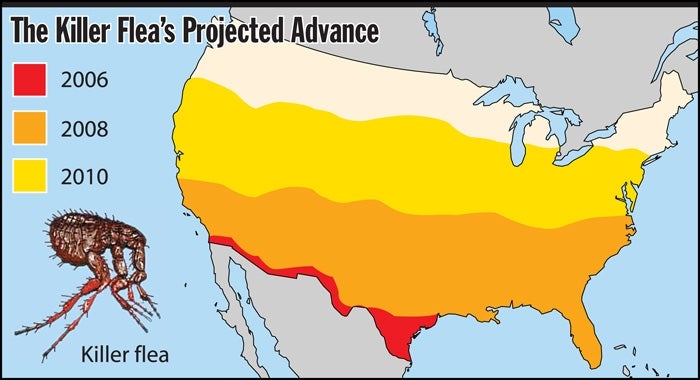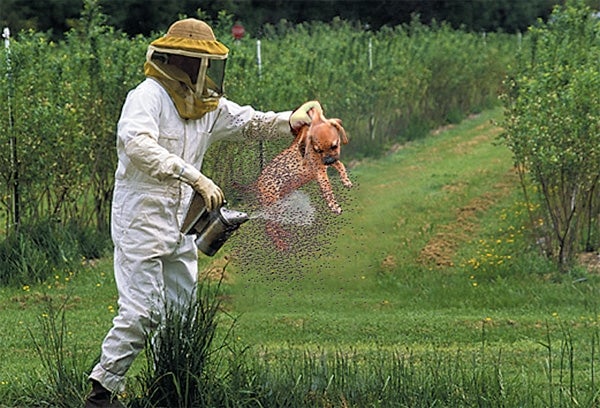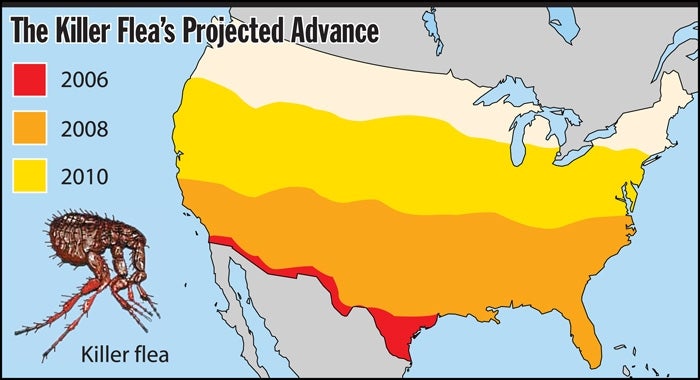ATLANTA—Panic is spreading among American dog owners, following the Center for Veterinary Medicine’s Monday announcement that the arrival of a deadly mutant strain of Africanized killer fleas is imminent.

“No dog is safe,” CVM director Stephen Sundlof said. “While canines around the U.S. innocently fetch sticks and chase their tails, killer fleas are migrating north at a rate of two kilometers a day. They’ve already invaded the border towns of Texas and California. We’ve got to act now, before our pets pay the price.”
Killer fleas, a staple of ’70s B-movies like The Bloodsucking Swarm, I.T.C.H., and Roger Corman’s Night Of The Fleas, are not, in fact, poisonous. The danger lies in the parasites’ excessive defensiveness, extreme resilience, and tendency to swarm.
“Africanized fleas are capable of draining a full-grown collie in less than 24 hours,” Sundlof said. “They attack in massive numbers, sometimes completely covering the animal, leaving only his eyes and tongue visible. Even if given a blood transfusion, a dog infested with Africanized fleas will often scratch himself so vigorously that he either bleeds to death or collapses from exhaustion. And regular flea powders are useless against them.”
Minneapolis veterinarian Greg Schepke said widespread fear of the deadly pests is justified.
“It’s hard to separate fact from fiction, as most of the information we have about the fleas is anecdotal,” Schepke said. “But if the stories are even half true, killer fleas are capable of cutting a swath of death across our nation, dotting the land with brittle, desiccated doggie husks.”
Bred in Brazil at the Sao Paulo Animal Research Facility in the late ’60s, Ctenocephalides canis africanus is a crossbreed of the common North American flea and an African variant that infests the tough hides of bull elephants. The Sao Paulo entomologists never meant to release the mutant fleas into the wild, but a 1974 fire at the lab led to the dangerous subspecies’ escape. In the past 30 years, Africanized fleas spread from Brazil to South and Central America and on to Mexico.

According to legend, the fleas crossed the U.S. border for the first time in June 2003, when Mexican flea-circus owner Pedro Romero brought his show to McAllen, TX. Romero, whose bone-dry corpse was discovered outside the Hidalgo County fairgrounds, is said to be single-handedly responsible for bringing the menace to America.
“The threat that once seemed straight out of a Saturday afternoon science-fiction matinee is now real,” said entomologist Harvey Smithson, author of the Africanized-flea tracts Unleashed! and No Day At The Park. “With no natural predators in America, these super-fleas will be unstoppable. They can jump from dog to dog at distances of up to 35 yards. One doghouse after another will be surrendered to the marauding fleas.”
Police sergeant Tom Lafferty, head of the Laredo K-9 Korps, said his force is taking serious measures to prepare for the killers’ arrival.
“We’ve reinforced all our doghouses with quarter-inch steel plates—killer fleas can burrow through concrete like cardboard,” Lafferty said. “And don’t bother with plastic flea collars. Killer fleas chew straight through those.”
Added Lafferty: “The force over in Asherton has already lost 10 of their best dogs.”
Basset hound owner Hank Jeffreys of Carpentersville, IL said the government must protect the nation’s pets.
“I hear the Feds developed a top-secret super-shampoo, but it’s too dangerous to use because it contains radioactive isotopes,” Jeffreys said. “How am I supposed to keep my Woofers safe? Even if you isolate the furry little victim and subject him to chemical baths, there’s a danger of immediate re-infestation. At this point, the only effective treatment is the mega-flea-collar, but it weighs 45 pounds and gives off such intense fumes that it makes dog owners hallucinate.”
In spite of the impending infestation of America, Sundlof urged dog lovers to remain calm.
“Should your dog become infested, isolate the animal and contact federal pest-control agents immediately,” Sundlof said. “When the killer mutant ringworm fungus arrived in Los Angeles from Tokyo, we developed ways to deal with it. We can lick this, too.”







